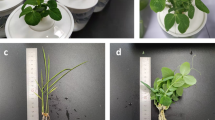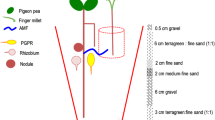Abstract
Aims
Rice is often cultivated in drought-prone regions causing growth inhibition. Therefore, we investigated whether close mixed planting of rice with pearl millet would mitigate these effects.
Methods
We used pot and lysimeter to evaluate whether close mixed planting with pearl millet is more effective than single-stand planting in suppressing the growth inhibition of rice (NERICA4) under drought.
Results
Close mixed planting only slightly alleviated the growth inhibition of rice under drought in the pot experiment and the first year lysimeter experiment, but mitigated this in the second year lysimeter experiment due to the lower levels of competition. Deuterated water applied from the bottom of the pot and lysimeter was present at a higher concentration in the xylem sap of rice under close mixed planting than under single-stand planting, and this tendency was enhanced by drought. Partitioning of the available water between the two crops was also observed under close mixed planting, with the rice and pearl millet depending on water from the soil surface and deep soil, respectively.
Conclusions
Close mixed planting with pearl millet effectively mitigates the growth inhibition of rice under drought due to the increased access to deep water and the partitioning of available water between the two crops.



Similar content being viewed by others
References
Araki H, Iijima M (1998) Rooting nodes of deep roots in rice and maize grown in a long tube. Plant Prod Sci 1:242–247. https://doi.org/10.1626/pps.1.242
Araki H, Iijima M (2005) Stable isotope analysis of water extraction from subsoil in upland rice (Oryza sativa L.) as affected by drought and soil compaction. Plant Soil 270:147–157. https://doi.org/10.1007/s11104-004-1304-2
Awala SK, Yamane K, Izumi Y, Fujioka Y, Watanabe Y, Wada CK, Kawato Y, Mwandemele OD, Iijima M (2016) Field evaluation of mixed-seedlings with rice to alleviate flood stress for semi-arid cereals. Europ J Agron 80:105–112. https://doi.org/10.1016/j.eja.2016.07.003
Corak SJ, Blevins DG, Pallardy SG (1987) Water transfer in an alfalfa/maize association. Plant Physiol 84:582–586
Dar MH, Singh S, Singh US, Zaidi NW, Ismail AM (2014) Stress tolerant rice varieties – making headway in India. Annu Tech Issue 18:1–14
Dobermann A, Fairhurst TH (2000) Rice: nutrient disorders and nutrient management. Potash and Phosphate Institute, International Rice Research Institute, Singapore, pp 254
FAO (2015) FAOSTAT Online Database. http://faostat3. fao.org/home/E. Accessed 01 Dec 2017
Fujita K, Ofosu-Budu KG, Ogata S (1992) Biological nitrogen fixation in mixed legume-cereal cropping systems. Plant Soil 141:155–175. https://doi.org/10.1007/BF00011315
Gowda VRP, Henry A, Yamauchi A, Shashidhar HE, Serraj R (2011) Root biology and genetic improvement for drought avoidance in rice. Field Crop Res 122:1–13. https://doi.org/10.1016/j.fcr.2011.03.001
Iijima M, Izumi Y, Yuliadi E, Sunyoto AWS (2004) Cassava-based intercropping systems on Sumatra Island in Indonesia: productivity, soil erosion, and rooting zone. Plant Prod Sci 7:347–355. https://doi.org/10.1626/pps.7.347
Iijima M, Awala SK, Watanabe Y, Kawato Y, Fujioka Y, Yamane K, Wada KC (2016) Mixed cropping has the potential to enhance flood tolerance of drought-adapted grain crops. J Plant Physiol 192:21–25. https://doi.org/10.1016/j.jplph.2016.01.004
Kamoshita A, Babu RC, Boopathi NM, Fukai S (2008) Phenotypic and genotypic analysis of drought-resistance traits for development of rice cultivars adapted to rainfed environments. Field Crop Res 109:1–23. https://doi.org/10.1016/j.fcr.2008.06.010
Keiser J, Utzinger J, Singer B (2002) The potential of intermittent irrigation for increasing rice yields, lowering water consumption, reducing methane emissions, and controlling malaria in African rice fields. J Am Mosq Control Assoc 18:329–340
Kumar A, Dixit S, Ram T, Yadaw RB, Mishra KK, Mandal NP (2014) Breeding high-yielding drought-tolerant rice: genetic variations and conventional and molecular approaches. J Exp Bot 65:6265–6278. https://doi.org/10.1093/jxb/eru363
Muthayya S, Hall J, Bagriansky J, Sugimoto J, Gundry D, Matthias D, Prigge S, Hindle P, Moench-Pfanner R, Maberly G (2012) Rice fortification: an emerging opportunity to contribute to the elimination of vitamin and mineral deficiency worldwide. Food Nutr Bull 33:296–307
Muthayya S, Sugimoto JD, Montgomery S, Maberly GF (2014) An overview of global rice production, supply, trade, and consumption. Ann N Y Acad Sci 1324:7–14. https://doi.org/10.1111/nyas.12540
Nanhapo PI, Yamane K, Iijima M (2017) Mixed cropping with ice plant alleviates the damage and the growth of cowpea under consecutive NaCl treatment and after the recovery from high salinity. Plant Prod Sci 20:111–125. https://doi.org/10.1080/1343943X.2017.1282828
Polley HW (2002) Implications of atmospheric and climatic change for crop yield and water use efficiency. Crop Sci 42:131–140
Sekiya N, Yano K (2004) Do pigeon pea and sesbania supply groundwater to intercropped maize through hydraulic lift? -hydrogen stable isotope investigation of xylem waters. Field Crop Res 86:167–173. https://doi.org/10.1016/j.fcr.2003.08.007
Setter T, Belford BJ (1990) Waterlogging: how it reduces plant growth and how plants can overcome its effects. Agric West Aust 31:51–55
Zegada-Lizarazu W, Iijima M (2004) Hydrogen stable isotope analysis of deep root water acquisition and hydraulic lift of sixteen food crop species. Plant Prod Sci 7:427–434. https://doi.org/10.1626/pps.7.427
Zegada-Lizarazu W, Kanyomeka L, Izumi Y, Iijima M (2007) Water acquisition from the seasonal wetland and root development of pearl millet intercropped with cowpea in a flooding ecosystem of northern Namibia. Plant Prod Sci 10:20–27. https://doi.org/10.1626/pps.10.20
Acknowledgements
We thank the members of the projects entitled ‘Flood- and Drought-adaptive Cropping Systems to Conserve Water Environments in Semi-arid Regions’ by the framework of the ‘Science and Technology Research Partnership for Sustainable Development (SATREPS)’ funded by both the Japan Science and Technology Agency (JST) and Japan International Cooperation Agency (JICA). We also thank Kashio C., Mori K., Okaich S., Nishio S. and other member of crop science laboratory of Kindai University for their assistance.
Author information
Authors and Affiliations
Corresponding author
Additional information
Responsible Editor: Martin Weih.
Rights and permissions
About this article
Cite this article
Yamane, K., Araki, C., Watanabe, Y. et al. Close mixed planting with pearl millet improves drought tolerance in rice by the increased access to deep water. Plant Soil 423, 397–410 (2018). https://doi.org/10.1007/s11104-017-3526-0
Received:
Accepted:
Published:
Issue Date:
DOI: https://doi.org/10.1007/s11104-017-3526-0




